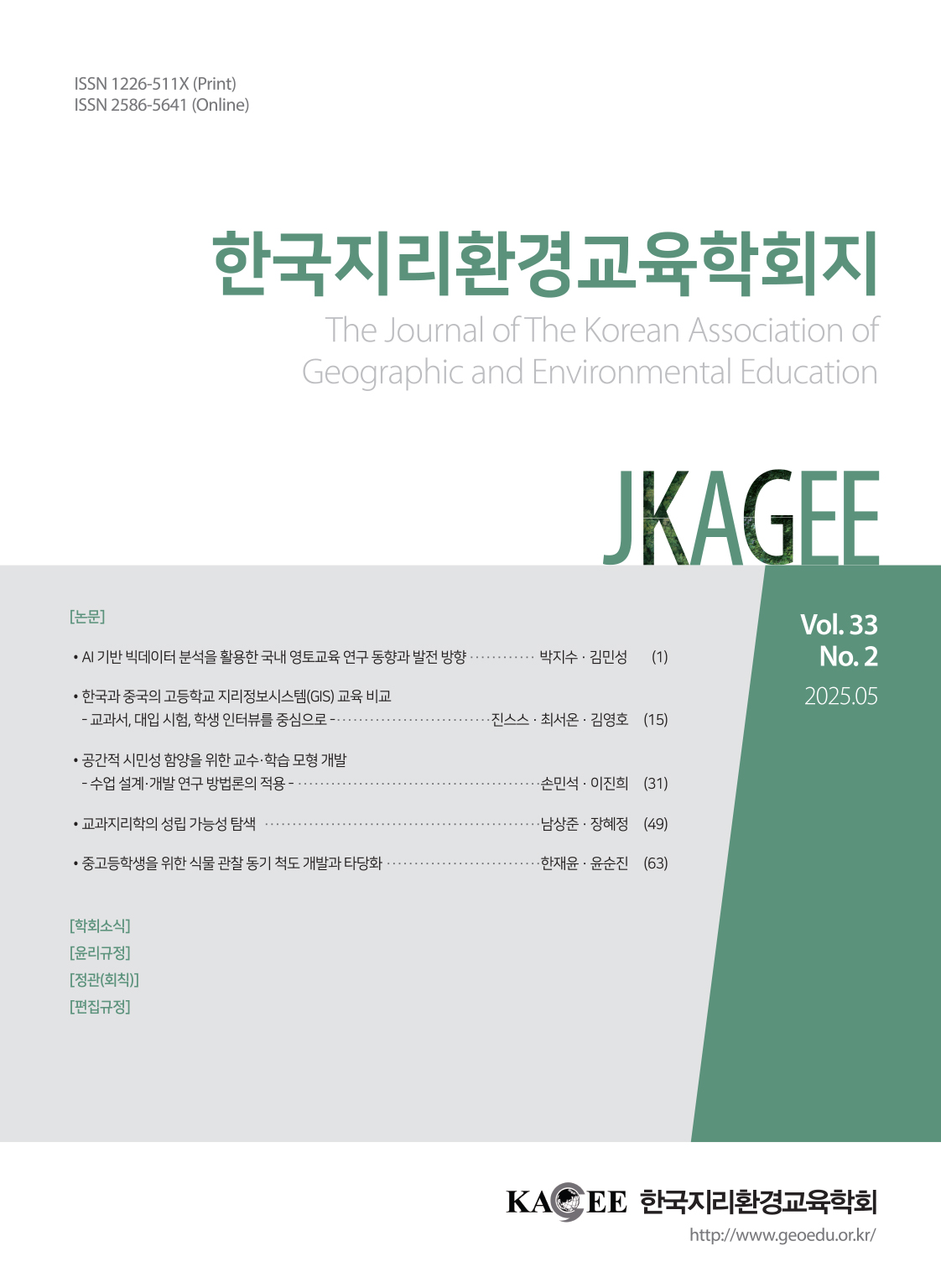Research Article
Abstract
References
Information
This study compares and examines the characteristics of geographical assessment of four South Asian countries: India, Pakistan, Bangladesh, and Sri Lanka. Their geographical assessment is divided into two domains, physical geography and human geography, in terms of form, and each domain takes a test system that is subdivided into several sub-sections. There is a higher proportion of the supply type than the multiple-choice type. The items have in common that they are a set-type item format composed of several sub-problems. Accordingly, in terms of content, it is a systematic theme center of physical geography and human geography, and has a common point in that the two areas occupy almost equal weight. However, India and Sri Lanka are relatively differentiated in that they place importance on understanding their own geography, Pakistan on physical geography and world geography, and Bangladesh on understanding geography methodology. And all of them are intended to evaluate various levels of geographical thinking on geographical ideas and phenomena, but they have shown in common that they mainly focus on retaining or applying prior knowledges rather than geographical inquiries. However, relatively, Bangladesh tends to evaluate different levels of geographical thinking skills, and Pakistan tends to evaluate the reproducibility of relatively simple knowledge of geographical facts. Overall geographical evaluation of Sri Lanka and India was ahead of Bangladesh and Pakistan in terms of quality and quantity. In particular, the blank map-based questions of Sri Lanka and India were noted in that they were faithful to the basics of geography learning such as location and distribution.
이 연구는 인도, 파키스탄, 방글라데시, 스리랑카 등 남아시아 4국의 지리평가가 지니는 특성을 비교 고찰한 것이다. 4국의 지리평가는 형식면에서 자연지리와 인문지리의 두 영역(domain)으로 대분되고 각 영역은 몇 개의 하위부문(section)으로 세분되는 시험편제를 취하며, 선택형보다는 서답형의 비중이 높고, 서답형 문항은 여러 하위 문제로 구성된 세트식 문항체제라는 공통점이 있다. 이에 따라 내용면에서도 자연지리와 인문지리의 계통적 주제 중심으로서 두 영역이 거의 동등한 비중을 차지한다. 그렇지만 상대적으로 인도와 스리랑카는 자국지리, 파키스탄은 자연지리 및 세계지리, 방글라데시는 지리방법론에 대한 이해를 중시하는 차별화를 보였다. 그리고 모두 지리적 사상 및 현상에 대한 다양한 수준의 지리적 사고를 평가하고자 의도하고 있으나, 대체로 지리적 탐구보다는 선지식의 파지나 적용 위주라는 공통점을 보여준다. 그렇지만 상대적으로 방글라데시는 다양한 수준의 지리적 사고력을, 파키스탄의 경우 비교적 단순한 지리적 사실지식의 재생력을 평가하려는 경향이 나타났다. 형식과 내용면에서 전반적으로 스리랑카와 인도의 지리평가가 방글라데시와 파키스탄보다 질적 및 양적으로 앞서 있었다. 특히 스리랑카와 인도의 백지도기반 문항은 위치와 분포 등 지리학습의 기본에 충실한 형식이라는 점에서 주목되었다.
- 강용옥, 2009, "한국과 인도의 사회과교육 비교 연구: 교과서 내용 분석과 상대국에 대한 인식을 중심으로", 시민교육, 41(2), 1-23.
- 공은애・강창숙, 2016, "대학수학능력시험 지리 문항에서 제시되는 그래프의 유형과 특징", 24(1), 119-137. 10.17279/jkagee.2016.24.1.119
- 이간용, 2013, "프랑스의 지리 평가 특성 분석: 바칼로레아 지리 시험을 중심으로", 대한지리학회지, 48(5), 786-801.
- 이간용, 2014, "러시아의 지리 평가 특성 분석: 국가통합시험((ЕГЭ)을 중심으로", 한국지리환경교육학회지, 22(1), 131-146. 10.17279/jkagee.2014.22.1.131
- 한국대학신문, 2018.01.26., "대학수학능력시험, 논서술형으로 바뀔까".
- Anderson, J. and Lightfoo, A., 2019,
The School Education System in India: An Overview , British Council, 18-20, https://www.researchgate.net/publication/335022177_The_school_education_system_in_India_An_overview. - Central Board of Secondary Education, 2018, Senior School Curriculum 2019-20 class Ⅺ-XII, Geography Course Structure, http://cbseacademic.nic.in/curriculum.html.
- Chowdhury, R. and Sarkar, M., 2018, Education in Bangladesh: Changing Contexts and Emerging Realities, in
Engaging in Educational Research: Revisiting Policy and Practice in Bangladesh , Springer Nature, https://www.researchgate.net/publication/328010382_Education_in_Bangladesh_Changing_Contexts_and_Emerging_Realities. 10.1007/978-981-13-0708-9_1 - Department of Social Sciences National Institute of Education Maharagama Sri Lanka, 2018, G.C.E (Advanced Level) Geography Teachers' Guide Grade 12-13, http://www.nie.lk/.
- Federal Board of Intermediate and Secondary Education Islamabad, 2020, Scheme of Studies for HSSC (Classes XI-XII), https://www.fbise.edu.pk/syllabusHSSC.php.
- Government of the People's Republic of Bangladesh, National Education Policy 2010, https://reliefweb.int/sites/reliefweb.int/files/resources/02.National-Education-Policy-2010-English.pdf.
- Hossain, M. Z., 2015, National Curriculum 2012: Moving Towards the 21st Century, Bangladesh Education Journal, https://www.bafed.net/pdf/ejune2015/1_National_ Curriculum_2012_Moving_Towards_the_21_Century.pdf.
- Ministry of Human Resource Development Government of India, 2019,
National Education Policy 2020 . - National Curriculum and Textbook Board, National Curriculum 2012 Geography XI and XII class, https://teachingbd24.com/national-curriculum-classxi-xii/.
- Relph E., 1985, Geographical experiences and being-in-the-world: The phenomenological origins of geography, in Seamon D. & Mugerauer R. (eds),
Dwelling, Place and Environment . Springer, Dordrecht. 10.1007/978-94-010-9251-7_2 - 남아시아 4국의 지리 시험 문항 사이트: 인도(http://cbseacademic. nic.in/web_material/SQP/ClassXII_2020_21/Geography-SQP.pdf 및 http://cbseacademic.nic.in/SQP_ CLASSXII_2020-21.html), 파키스탄(https://www.fbise.edu.pk/Old%20Question%20Paper.php), 스리랑카(https:// www.doenets.lk/pastpapers), 방글라데시(https://boardmodelpaper.com/bd-hsc-suggestion-all-board-hsc-alim-vocational-bm-suggestion-question-pattern/).
- Publisher :The Korean Association Of Geographic And Environmental Education
- Publisher(Ko) :한국지리환경교육학회
- Journal Title :The Journal of The Korean Association of Geographic and Environmental Education
- Journal Title(Ko) :한국지리환경교육학회지
- Volume : 29
- No :3
- Pages :1-21
- DOI :https://doi.org/10.17279/jkagee.2021.29.3.1



 The Journal of The Korean Association of Geographic and Environmental Education
The Journal of The Korean Association of Geographic and Environmental Education







